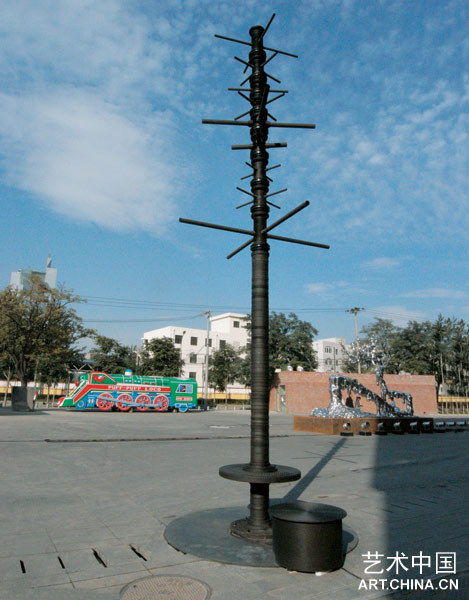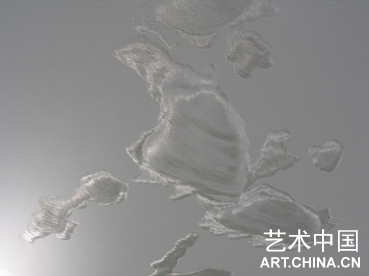
展览名称:《6.5维》——史晶个展
Exhibition: 6.5 Dimensions – Shi Jing Solo Exhibition
策展人:江铭
Curator: Jiang Ming
开幕酒会:2007年 11月15日下午三点
Opening Reception: at 3:00 p.m. on November 15, 2007
展览时间:2007年 11月 15日-2007年 12月 15日
Exhibition Run: November 15, 2007 -2007, December 15
展览地点: 印尼华艺莎艺术中心
Location: Vanessa Art Center Jakarta

评论:
6.5维
6.5 Dimensions——史晶解剖性作品的研究
shijinganatomical study of the works
江铭/文
史晶的作品明显地与当代艺术的所谓观念性有一定的距离!他的作品是自我体验性实验的典范!我们从什么样的角度解读史晶的作品关系到我们如何重新思考艺术与人类的关系的本质属性问题!在史晶的世界里,艺术是艺术家的个体体验的产物,而经验是第二位。他认为人的直觉是最宝贵的东西,直觉往往很准确,而人的经验却可能出错,所以他不相信经验的东西。于是他的艺术也从直觉出发了。在那些单纯的画面上他将色彩完全抽空,来尝试体验单纯的笔触与感觉的通畅度,他所要体验的正是绘画与人的关系,他所注重的是个体在现实中真切的精神体验。
Shi Jing’s works obviously stand apart from the so-called conceptuality of contemporary art! His works are the standard-bearers for self-practiced experimentation! The perspective we choose for decoding Shi Jing’s works is related to how we begin anew in pondering the quintessential issues of the relationship between man and art! In Shi Jing’s works, art is the product of the individual practice, with experience coming in second. He believes that a person’s intuition is a valuable thing. Intuition is often correct, but experience can be wrong, so he doesn’t believe in the stuff of experience. This is why his art begins with intuition. In those innocent pictures, he completely empties the colors and gets a feel for the connection between simple strokes and feeling. What he wants to get a feel for is the relationship between painting and person. What he emphasizes is the true spiritual feeling in reality.
普通的观众面对史晶的作品也许根本无从阅读,因为他作品的多重维度被隐藏在表象中,视觉的误读对产生于质感的东西无法用语言来形容!所以解读他的作品含义是第二位的,而我们如何准确地,尽可能接近性地描述他的作品反而显得更加重要。他的作品在描述之中意义就完全地显现出来了!
When the common audience encounters Shi Jing’s works, it may have no idea where to begin in reading them, because many dimensions are hidden within the images. The sensual perceptions created by visual misreading are impossible to put into words! Therefore decoding the meaning of his works is secondary, while the most proper, closest way for us to describe his works becomes more important. In the course of describing his works, the significance becomes fully apparent!
史晶的作品我们可以用维度的关系来分析,其作品的几个部分呈现出几种不同的效果和感受。如果我们将具像绘画的三维空间进行解剖,将正面、左侧面、右侧面运用成像度来确定,那么当我们正面面对那组灰、白系列作品的画面时,我们感到那些图像显现出一种模糊的、脆弱的、冷静的印象,这种印象在很多人的经验里是不满意的状态,因为我们无法准确而又确切地捕捉到那个我们似乎已经朦胧看到却不能够被显影的图像!这种感觉就像我们身处的世界,我们所面对的现实,我们所看到的那些事件、状况、现象、我们似乎能够捕捉到一些什么,但是我们又无法确切地知道那些真实的东西。在这个正面视觉印象中我们所能够见到的就只有0.5个维度,连1个维度都没有,它是不完整的,另外那半个维度被隐藏起来,我们不知道它在什么地方。但是当我们的观察视角发生变化的时候,随着脚步的移动,我们发现整个画面出现了不同的虚实变化与形体起伏凹凸的改变,原来平面化的画面开始出现具像的图形以及光影的微妙改变。甚至在某些时候我们还仿佛感受到他所描绘的那些图像在流动。在那组白色画面的作品中,我们体验到这样的感受,即当我们从画面的正面移动脚步向左或者向右的时候,画面上开始显现出某种特殊效果的、泛起银白色光泽的具象的某些形象。于是我们感到一种喜悦,这种喜悦就好象我们突然发现了某种被隐藏起来的东西,那种感受很特别,让人惊喜。那些图像是清晰的但又是倾斜的,我们内心的满意度被稍稍削弱了,我们如果用准确的数字来表述,这个视角应该有1.5个维度,因为倾斜之后的维度应该减少0.5,透视关系再减去1个维度,剩下的部分就只有1.5维了。左右两边的视觉维度都是这个数值1.5,而视觉效果却是相反的关系。于是当我们看完作品之后,我们的内心里面将会合成一个图像,这个图像呈现具像的东西但是仍然不是完整的,这个心里合成的图像仍然不是3维的,它至多只能够达到2个维度的关系。
We can use dimensional relationships to analyze Shi Jing’s works, as various parts of his works present different effects and understandings. If we dissect the three-dimensional space of a concrete painting, defining the front, left and right sides by how they create the image, then when we face the images of those gray and white series, we will feel that those images present murky, weak and cold impressions, and this is unsatisfactory in the many people’s experience, because we cannot properly and fully capture an image that we had blurrily seen but couldn’t put our finger on! This feeling is reminiscent of the world in which we live. With the reality we face, the things we see, the situations and phenomena, we can almost grasp something, but we can never really know its truth. In this head-on visual image, we can only see half a dimension, not even a single full one. It is incomplete; the other half-dimension is hidden, whereabouts unknown. But when our observational perspective is changed, as when we take a step, we notice that the entire image has undergone a virtual change and the form attains depth. An image that was once flat starts to appear as a concrete image with minute changes in lighting and shading. Sometimes it is almost as if we can perceive movement in those images he sketched. In those white works, we can feel this sort of perception, and if we step to the left or the right, special effects appear in the image, emerging as silver-white forms of some sort. This brings us a bit of joy, like when we suddenly discover something that was hidden. That’s a special kind of feeling, a happy one. Those images are clear yet skewed, and our satisfaction level is dropped a notch. To use the correct numbers, this perspective has 1.5 dimensions, because the skew subtracts 0.5 and the transparency subtracts another full dimension, leaving us with 1.5 dimensions. The left and right perspectives are each at the value of 1.5, and the images are opposite. So after we see the work, our minds put them together as a single image. This image appears concrete, but is still incomplete; this mental composite still falls short of 3 dimensions, only adding up to two.
我们将作品的整个维度数值相加在一起也就是我们面对他一件作品所获得的整体感受,这种感受远远超出了我们面对其他绘画作品直接呈现给我们的心理视觉,那些作品从画面感受上只有3个维度的空间关系,而史晶的作品却达到了0.5+1.5+1.5+2=5.5的维度。这也就是很多的人面对着史晶作品所感受到的那种特殊性,我们感受到他的作品与我们所习惯看到的事物关系的不同,但是我们无法确定那些不同究竟来源于什么方面。他从艺术自身的语言研究出发,找到一种特殊的方法,为我们打开了一扇能够通向精神领域的多个端口,这扇门很窄,找到他的人并不是很多。
If we add all of the dimensional values in a work together, which is the overall perception of one of his works, this perception far surpasses the psychological vision that we get directly from other works. Those other works only have a three-dimensional spatial relationship, but Shi Jing’s works have reached 0.5+1.5+1.5+2=5.5 dimensions. That is the peculiarity that many people perceive when faced with one of Shi Jing’s works. We get the feeling that his works are different from the things we’re used to seeing, but we can’t decide from exactly where that difference arises. He set out from the research of artistic language, found a special method, and opened for us a door that leads to many windows into the spirit. This is a very narrow door, and few people succeed in finding it.
在他的黑色系列的那些作品中我们会感受到另外的不同,他的黑色画面的作品,譬如伦勃朗的那组作品,都是在灯光下作业的,他尝试着用颜料表面的油质反光来成像。在这组作品中我们能够体验到打开灯光与不打开灯光时截然不同的外在视触觉与内在心理触觉的复杂变化。在不打开灯光的情况下,我们正面面对画面时,图像呈现出残缺的状况,这种残像只有0.5的维度,而打开灯光的时候则是3维立体的完整效果,不过这个效果只能在左右30°的夹角范围内才能够看到,超出这个范围则没有了。而随着这个视角的继续加大之后我们会发现图像重新变得残缺不全,在左右两边的成像度都只有0.5维。在观赏这组作品之后,我们的内心仍然会合成一个心里的视觉形象,这个形象也不是完全3维的,我们也应该将它确定为2个维度。
In his black series we find a different kind of difference. His black paintings, like the Rembrandt series, were done under light. He was dabbling with the use of an oily finish to reflect the image. With these works, we can get a feel for the complex visual and psychological changes between when the light is on and when it is off. When the light is off, and we face it head-on, the image appears in an incomplete state, and this state is only 0.5 dimensions. When we turn on the light it is in full 3 dimensional effect, though it can only be seen within thirty degrees to the right or left. Once we leave this radius, the effect is gone. Past this field the image is once again incomplete, and we only get 0.5 dimensions. After viewing these works, we can once again synthesize a mental visual form. This form isn’t fully 3 dimensional, and we should define it as 2 dimensional.
那么我们最终在这组作品中所获得的外在与内在的总体的体验将能够达到6.5个维度,即0.5+3+0.5+0.5+2=6.5维。
Then, in this series of works, the overall dimensionality from internal to external comes out to 6.5 degrees, as such: 0.5+3+0.5+0.5+2=6.5.
这组黑色的作品给我们一种潜入心灵的神秘的东西,当灯光亮起来的时候,我们看到很明确的图像,但是我们感受不到这个图像的真实性,它是一种假象。而灯光熄灭的时候,那种残缺的画面又折磨我们的视觉,我们总是想移动视线,想从某个角度找到那个被隐藏起来的东西。可是那个被隐藏起来的究竟是什么呢?在这组作品中灯光成为绘画的一个合理的组成部分。
This series of black works gives us something mysterious that reaches the soul. When the light is turned on, we see a definite image, but we cannot perceive the reality of this image, as it is a façade. When the light is extinguished, that incomplete image comes to mess with our vision; we always want to move the line of sight, hoping to find that hidden thing through a certain perspective. But what, after all, is that which was hidden? In this series of works, light has become a reasonable component of the painting.
史晶的第三个实验体现在《黑森林》、《废园》这样的作品中,这些作品是在一个或者多个颜色的灯光下进行的,他仍然使用单一的颜色,但是对这些作品的描绘可以不注意任何的形象与素描关系,而是可以胡乱的涂点,他企图使图像的感光度达到普通数码相机的模式,而与人的肉眼的感光拉开距离。他发现人眼与数码相机之间有一个夹层,这个夹层可能是被我们曾经忽略的灰色地带。他想探求这个灰色的地带究竟有着怎样的可能性和多大的领域。从而我们发现在这个灰色的地带中,抽象表现主义、神秘主义以及现实主义其实都共生在一个时空中,相互之间可以任意转换与置换。
Shi Jing’s third experiment is embodied in works such as Black Forest and Waste Field. These works were made under a light or number of lights, and though they are also monochrome, this sketching could be done with no attention to the relationships of forms, instead they can be chaotically scribbled. He attempted to use the image’s light sensitivity to reach the level of a common digital camera, and create a distance from the light sensitivity of the human eye. He realized that there is a level between the human eye and the digital camera, which might be a gray zone that we previously ignored. He wanted to explore the potentials and scope of this gray zone. In this gray zone we discover that abstract expressionism, mysticism and realism all live within the same time and space, and that they are all mutually interchangeable.
在这组作品中对于它的维度应该这样描述,即所有角度,我们视觉的成像都是0.5维,无论在左、中、右哪个角度。而数码相机所呈现的图像则是3维的效果,再加上我们内心所描述的2个维度,这组作品仍然给我们造成0.5+0.5+0.5+3+2=6.5维的总体感受。
The dimensionality of these works should be explained in this way – from any perspective, the visual image is 0.5 degrees, whether the perspective is left, center or right. The digital image is a 3 dimensional effect, and our internal depiction is 2 dimensions, so this series still gives us 0.5+0.5+0.5+3+2=6.5 dimensions overall.
从这组作品中我们会发现原作可以是不完整的。画册与传媒可以是不真实的。真实的画面与传播的图像可以完全是两回事。面对这样一种情状,我们该相信谁?真实与假象之间究竟有着怎样的距离?看来面对这些作品我们所感受到的已经不仅仅是视触觉的不同与奇特。它所带给我们的东西已经远远超出了绘画本身。
From this series, we can see that the original work doesn’t have to be complete. Catalogues and media can be unreal. The real image and the broadcasted picture can be completely different things. When faced with such a situation, which do we believe? What is the true distance between the real and the false? It would seem that in these works what we perceive is not merely limited to visual differences and oddities. What it brings us has vastly transcended painting.
在我们全部的生命与生活中,是什么东西使我们满意或者不满意?在全部的生命中,我们见到的一切,有多少是真实的、可以把握的、能够持久的?又有多少东西是短暂的、残缺的、破碎的?究竟什么是我们全部生命感知中的意义与价值?我们精神的世界究竟有着怎样广阔的可能性和神秘地带?
In the entirety of our lives, what is it that makes us satisfied or unsatisfied? Among all the things we see throughout our lives, how much of it is real, graspable and lasting? How much of it is temporary, incomplete and fragmented? What, in the end, is the significance and value of our lifelong perceptions? What breadths of potential and mysterious realms are to be found in our spiritual world?
面对史晶的作品,我们被另外的一种审美所捕获。这些东西区别于我们普遍所见到的很多的强权性作品,那些作品被赋予了明确的“观念性”与“意义性”,他们往往使我们感受到某种来自于艺术家所赋予的说教性特征,他们在给我们这些欣赏者进行某种政治的、文化的、艺术的说教。但是在很多的时候,我们不能够懂得作品直接所呈现出来的东西,于是艺术家只好借助于理论阐释,编织出许多的象征性、引申性的意义来试图说服我们。阅读这样的作品我们需要借助文字或者语言,而视觉的直接性的感受往往变的无关紧要。史晶的作品其实是对于这样一种艺术倾向的批判性的实验,在这个层面上有着重要的价值。他使我们重新思考架上绘画的本质性问题以及视觉艺术与哲学、政治学、文学等相关学科到底应该有着怎样的差异。
When facing Shi Jing’s works, we are captured by an entirely different aesthetic. This stuff is different from so many powerful works that are commonly seen, works that have been correctly dubbed “conceptual”. They often give us a perception of the artist’s preaching, like the artist is preaching some kind of politics, culture or art. But we are often unable to understand what the work is directly presenting to us, so the artist must resort to the use of reasoning and explanation, to weave symbolic and extended meaning to convince us. When reading into these works, we must make use of text and language, and the visual directness often loses importance. Shi Jing’s works are actually an experiment in critique of this artistic trend, and on this level it is very valuable. He makes us once again consider the essential issues of the painting on the frame, and what contrast the visual art should have with such sciences as philosophy, political science and literature.
中国的当代艺术是西方价值系统的延续性产物,但是今天的中国现实却使西方人惊讶地发现,中国人把这个由西方人所殖民的历史演变成为中国人自我重新把玩的新游戏!很多被套用在中国本土的西方的体系与模式越来越显得生硬而不合身!于是中国人开始为自己打造历史与游戏规则,而且不讲道理,只讲实用与适用!在史晶的价值观中这种本土的自我把玩的心态很是明显,这种东西有着强大的中国本土经验,这种经验是由中国传统文人士大夫的玩物的传统延续下来的基因。譬如中国人能够把一支毛笔和一张宣纸把玩出无数的微妙变化,而且乐此不彼,这绝不是西方人所能够理解的。今日中国的艺术家在他们内在基因里面仍然流淌着我们祖先的传统,无论我们如何标榜西方与现代,我们仍有着很多无法被殖民的东西。我们能够从史晶的作品中窥见到那些无法更改的东西,当然这种东西并不是外在的表面的,而是本质的,精神层面的,也是前卫的。
Chinese contemporary art is a product of the western values system, but China’s current reality would lead westerners to the startling discovery that the Chinese have taken the originally transplanted history and turned it into a game of their own! Many western systems that have been adopted by China seem rigid and ill-fitted! So the Chinese began to create their own rules for history and the game. They ignore reason, only paying heed to utility and suitability! This kind of personal play attitude is quite apparent in Shi Jing’s works. This stuff has a strong native Chinese experience, and this experience holds genes from the playthings of traditional Chinese scholars. It is like how the Chinese can make endless variations with a brush and a piece of paper, and take so much joy from it; this is something that westerners just can’t understand. Today’s Chinese artists still have the genes of their ancestors’ traditions flowing inside them, no matter how much we look up to the west. Of course, this isn’t on the surface. It is essential, on the spiritual level, and it is avant-garde.
史晶的作品在中国当代艺术的系统中成为比较特殊的一类,他不是从作品的外在观念出发,而是从绘画的语言结构出发达到一种他称之为“视触觉”的新领域。他所创造的方法论在中国当代艺术的系统中应该有着怎样的位置,我们还应该进一步深入研究。
In the Chinese contemporary art system, Shi Jing’s works stand in a particularly special category. They don’t set out from an external concept, but set off from the language of painting to enter into what he calls a realm of “visual contact”. As for where in the Chinese contemporary art system his original methodology should be placed, we should continue to explore.
2007年7月22
写于北京大山子环铁将府艺术区
July 22, 2007
Written in the Huan Tie Jiang Art District, Da Shanzi, Beijing
策展人简历:江铭,又名王宝明,中国大陆当代艺术批评家、独立策展人、艺术家,著有《中国后现代艺术》一书。
About the Curator: Jiang Ming, also known as Wang Baoming, is a Chinese contemporary art critic, independent curator, artist and author of Chinese Post-Modern Art.
|

